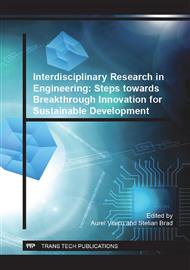[1]
K. T. Palmer, D. Coggon, H. E. NSyddall, et. al.: Occupational exposure to noise and hearing difficulties in Great Britain University of Southampton for Health and Safety Executive., Contract research report 361/2001, Great Britain, Southampton, ISBN 071762087-5, http: /www. hse. sov. uk/research/crr-pdf/2001/crr01361. pdf, (2001).
Google Scholar
[2]
M. J. Griffin: Hand-transmitted Vibration: Occupational Exposures and their Health Effects in Great Britain, 2001. University of Southampton, U.K. (1999).
Google Scholar
[3]
H. Mao, K. H. Yang, I. Albert, et. al. : Computational neurotrauma—design, simulation, and analysis of controlled cortical impact model, http: /www. Springerlink. com, Received: 4 August 2009 / Accepted: 19 March 2010 / Published online: 7 April 2010 © The Author(s), (2010).
Google Scholar
[4]
B. Rong, X. Rui, G. Wang et. al.: New efficient method for dynamic modeling and simulation of flexible multibody systems moving in plane. Multibody System Dynamics. 24: Number 2., DOI: 10. 1007/s11044-010-9196-9, Biomech Model Mechanobiol (2010).
DOI: 10.1007/s11044-010-9196-9
Google Scholar
[5]
A. Todea, A. Ferencz: Professional Morbidity in 2006 in Romania, Publish Health Institute, Work Medicine Institute, Bucharest, Romania, (2006).
Google Scholar
[6]
A. F. Pop, A. Truţa, M. Arghir: The mechanical stability for the hand-arm system. Vol. 8. 1: 79th Annual Meeting of the International Association of Applied Mathematics and Mechanics (GAMM). Bremen. Germany, (2009).
Google Scholar
[7]
T. Cherian, S. Rakheja, R. B. Bhat: An analytical investigation of an energy flow divider to attenuate hand- transmitted vibration, Concordia University, Canada, (1996), pp.455-467.
DOI: 10.1016/0169-8141(95)00003-8
Google Scholar
[8]
M. J. Griffin: Hand-transmitted Vibration: Occupational Exposures and their Health Effects in Great Britain, University of Southampton, U. K, (1999), pp.218-228.
Google Scholar
[9]
C. M. Harris, A. G. Piersol: Harris'Shock and Vibration Handbook, Columbia University, Fifth Edition, New York, ISBN 0-07-137081, (2002), p.1. 1-42. 62.
Google Scholar
[10]
J. Awrejcewicz: Classical Mechanics. Dynamics. Springer, New York, http: /www. amazon. com/s/ref=ntt_athr_dp_sr_1?_encoding=UTF8&sort=relevancerank&search-alias=books&ie=UTF8&field-author=Jan%20Awrejcewicz, (2012).
Google Scholar
[11]
H. Haider, P.S. Walker: Measurements of Constraint of Total Knee Replacement. Public Health Resources. Paper 43, Journal of Biomechanics 38, (2002).
Google Scholar
[12]
G. Kostin, V. Saurin: The method of integro-differential relation for linear elasticity problems. Arch. Appl. Mech. 76 Springer. DOI 10. 1007/S00419-006-0039-3, http: /www. springerlink. com/content/91732586501kp800/fulltext. pdf, (2006).
Google Scholar
[13]
M. Kutz: Mechanical Engineers' Handbook, A Wiley-Interscience Publication John Wiley &Sns. Inc,. Second Edition. Canada. ISBN-0-471-13007-9, s%20Handbook%20 (www. eBookByte. com)%20Ch-fm. pdf, (1998).
Google Scholar
[14]
H. Liu, P. J. Ellison, H. Xu, et al. : Coupling of dynamics and contact mechanics of artificial hip joints in a pendulum model. Proceedings of the Institution of Mechanical Engineers. Part H: Journal of Engineering in Medicine August 1, 224, DOI: 10. 1243/09544119JEIM687, (2010).
DOI: 10.1243/09544119jeim687
Google Scholar
[16]
A. Galton, T. Duran: Memis-Mheg environment for multimedia information and simulation. University of Strathclyde, Glasgow, U. K. 6: (1998), pp.3813-3816.
Google Scholar
[17]
P. J. Gyu: Vibration simulation using Matlab, Department of Precision Engineering. Kyoto University. Japan, http: /wenku. baidu. com/view/a02c33d5b9f3f90f76c61b29. html., (2008), pp.1-82.
Google Scholar
[18]
J. H. . Jacobs: Miniature vibration isolation system, Aerospace Conference Proceedings IEEE. USA. vol. 4, ISBN-0-7803-5846-5, (1998), pp.335-344.
Google Scholar
[19]
P. Urban, E. Lukas: Occupational diseases due to hand-arm vibration in the Czech Republic in the year. The Eight International Conference on Hand-Arm Vibration. Umeå. Sweden., (1997), pp.153-155.
Google Scholar
[20]
SREN 5349-2: 2003: Mechanical Vibrations. Measurements and evaluation of human exposure at vibrations transmitted of hand.
Google Scholar
[21]
SRCR 10 30-2: 2000: Hand-arm vibrations. Indications for reduce vibration risk. Part 2: the measure of prevention regarding the working place.
Google Scholar
[22]
SR ISO 7962: 1996: Mechanical vibrations. Transmissibility of mechanical vibrations of human body after z direction.
Google Scholar
[23]
SR ISO 8727: 2001: Mechanical vibrations and shocks. Human exposure, biodynamical system coordinates.
Google Scholar


